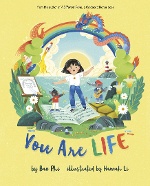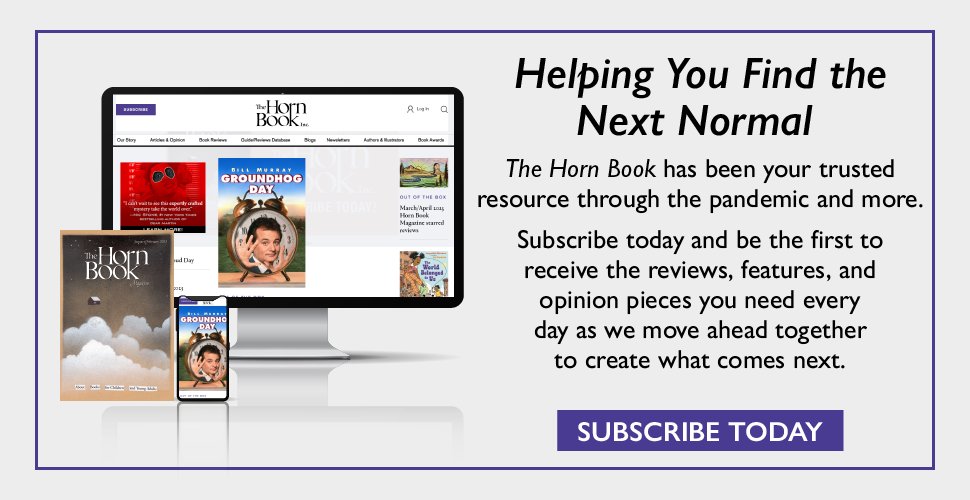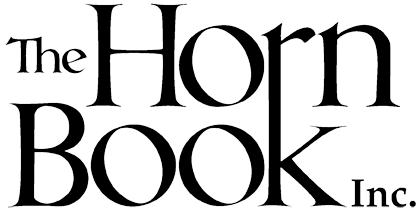Bao Phi Talks with Roger
In You Are Life, illustrated by Hannah Li, Minneapolis poet-author Bao Phi (winner of a Boston Globe–Horn Book Honor for A Different Pond) addresses the reader directly to celebrate who you are. Bao and I talk below about poetry, picture books, and how and where the two can meet.

Talks with Roger is a sponsored supplement to our free monthly e-newsletter, Notes from the Horn Book. To receive Notes, sign up here.
Sponsored by

In You Are Life, illustrated by Hannah Li, Minneapolis poet-author Bao Phi (winner of a Boston Globe–Horn Book Honor for A Different Pond) addresses the reader directly to celebrate who you are. Bao and I talk below about poetry, picture books, and how and where the two can meet.
Roger Sutton: As background, Bao, I’d like to ask you about your transition from poet to picture-book writer.
 Bao Phi: I didn’t plan it this way. My first picture book came out at the same time as my second book of poems for adults. I’ve been a spoken word artist for a very long time, well over two decades.
Bao Phi: I didn’t plan it this way. My first picture book came out at the same time as my second book of poems for adults. I’ve been a spoken word artist for a very long time, well over two decades.
RS: Can you define that for me? I want to make sure I know what you’re talking about.
BP: I was a performance poet in high school. This was back in 1991, 1992, before I knew the art form was called spoken word. I was really interested in oratory and rhetoric. Fast forward to doing poetry slams and then having a career as a traveling spoken word artist. People started paying me to perform in 1998. Spoken word is really, in terms of craft, the art of poetry plus performance, but those of us who consider ourselves spoken word artists have different aesthetics and different philosophies. My philosophy and aesthetic are that I write the poem and figure out if it is something I can deliver in a compelling fashion to an audience. And if so, how? Some poems don’t work in performance, but some do. It’s almost like curating a mix tape. I approach every performance of reading like craft. If the audience is a little bit restless, I probably need to do a poem at the beginning that gets their attention. And then once I get their attention, maybe I could do something quieter, or something that’s a little bit more experimental.
RS: Like pop stars who get the hit out of the way first. The audience gets something they like, and now the artist can try something different.
BP: It’s not unlike putting a poetry collection together. You have to be strategic and intentional about the order the poems are in. You’re not just throwing everything out there and hoping it sticks. It’s a strategic curatorial process. That’s the artistic part of it. The professional part of it is, I would get paid to travel and perform my poetry for many years. I’ve always had a full-time job in addition to my arts career. I’ve never taken the leap of saying I’m going to be a full-time artist.
I started writing picture books because I had a kid. We — myself and my former partner; we’re co-parenting — want our kid to be exposed to a lot of different stories and a lot of different people. Stories about Black people, American Indian people, Latinx, Arab, single-parent families, queer families, trans families, lower-income families, families from different cultures and from around the world. And at the same time, we were aware that American culture has a lack of awareness, at best, and a systemic erasure, at worst, of Asian American history. Where are the Vietnamese refugee stories? There was a part missing that was very specifically part of my kid’s life and their identity. I noticed a disconnect between my child and their grandparents, my parents, who are refugees from Vietnam, working class, working poor — a lack of awareness of my parents’ struggle. So as they are learning about all these great movements — Black-, Native American-, women-, and queer-led movements — they know nothing about the struggle of their grandparents. What is a refugee? What’s the difference between a refugee and an immigrant? It was that awareness of a lack of representation of working class, refugee, Vietnamese families, that drove me to write A Different Pond.
RS: Was it a children’s book from the get-go?
BP: It started as a poem. It was in the back of my mind to write a children’s book, but I didn’t know about what. I was getting a lot of encouragement from my fellow writers, many of them children’s book writers: Write a children’s book! Yeah, but about what? I knew that Asian American issues and refugee issues would be the heart of it. That’s the why. But the book is the what — I didn’t yet have the what. I was writing a poem a day, and I wrote about early fishing trips with my father — for food, not for sport. I thought, maybe this could be a children’s book. Not the poem, but the idea. That’s how A Different Pond came to be. I was not prepared, had no idea what reception it would receive.
RS: You took a lot of people by surprise. Capstone took a risk with this book.
BP: Credit to them. They took a risk, and they treated me like an equal. They wanted to hear my ideas about a lot of things. They very smartly hung in there and waited for the right illustrator, Thi Bui. Thi was our first choice, but she said no because she was too busy working on her graphic memoir for adults, The Best We Could Do. We were ready to move on, but my editor at Capstone, Kristen McCurry Mohn, said, “I think we should wait and ask her again when she’s done with her book, because she would be perfect.” Capstone was very smart with this project. Now I’m doing my fourth book with them.
RS: And You Are Life is very different. I’m not an artist, but let’s imagine I was a potential illustrator of this book. Oh, my God. There’s so much imagery here. It’s quite a challenge.
BP: You Are Life is different from my previous children’s books, which had, however loosely, narratives and characters. This is a poem, and as you said, it’s full of images. Two things I have in the back of my mind now when I’m writing children’s books are what reads aloud well and also would be fun to illustrate. I can’t just think about what’s happening between me and my creation. There’s going to be another creator coming in.
RS: You’ve got to leave room.
BP: Exactly. For me, it’s a fun process. I hope it has been for the illustrators, as well.
RS: In 1978, there was a picture book edition of “Stopping by Woods on a Snowy Evening,” the Robert Frost poem. “Whose woods these are I think I know...” The Horn Book was apoplectic about this book because they maintained, at the time, that you shouldn’t illustrate lyric poetry. You should let the images in the text speak for themselves. What’s your thought?
BP: I think that’s a very compelling point. Whenever someone says never do something, I ask myself, is that really true? There can be a redundancy, but at the same time, when I think about writing for kids, especially for very young children, I’m not sure if I’d say that rule would be useful. Kids may not be as familiar with the words, and the pictures supplement their understanding of the text. I see The Horn Book’s point, but I’m not sure if I agree it’s a hard-and-fast rule applicable to every context. Honestly, one of the freeing things I’ve found in working in children’s books is I don’t have to say everything in the story. The illustrator can do some of that work for me. For instance, in A Different Pond, I had a couple sentences about how the dad and the kid were fishing in a place where they weren’t allowed to be. I felt like that was an important part of the story. Obviously, not to encourage criminality but to say that sometimes when you’re poor, or you’re a refugee —
RS: You’ve got to eat.
BP: That’s exactly it. But I was struggling — how do you say that very complicated thing in a children’s book? The illustrator just drew a “no trespassing” sign. Rather than say you should never do something, I prefer to think that this is a process where you have to think about how another artist is going to engage with it. Think about what the illustrator can do and what their vision of it is.
 RS: You leave room for the illustrator. You also have to leave room for the reader. What really bothers me about J. K. Rowling is she can’t let it go. If you’ve ever read a Harry Potter novel, everything’s described, she tells you how to feel, she tells you how it looks. Most poetry and picture books need breathing room.
RS: You leave room for the illustrator. You also have to leave room for the reader. What really bothers me about J. K. Rowling is she can’t let it go. If you’ve ever read a Harry Potter novel, everything’s described, she tells you how to feel, she tells you how it looks. Most poetry and picture books need breathing room.
BP: That’s a great point. I hope that we accomplished that. Hannah Li did such a great job. Her illustrations aren’t just photorealistic representations of the text. That would be boring.
RS: She’s not imposing a narrative on it, either.
BP: Her art conjures beautiful, whimsical things. I feel like the writing and the art complement each other well. One of the most exciting parts of the picture book process is how joyful it is for me to see the first sketches by the illustrator. The day I get that email with the drafts and sketches, I’m always on the verge of tears. For me, it’s so magical to see these worlds the illustrators create. It’s great to be a part of that.
RS: Have you ever felt that an illustrator taught you something about your book that you didn’t know?
BP: Absolutely. Each one of them has. I’ll go back to A Different Pond, because out of all the illustrators I’ve worked with — all of them have been great — I worked most closely with Thi. She’s Vietnamese, so there were some things I didn’t have to explain to her; she’s the same generation as me, and she’s also a refugee from Vietnam. If I said, “fish sauce in a used mayonnaise jar,” she knew exactly what that meant, because that’s what her family did, too. Some of her questions made me realize I hadn’t located my story except for one mention of Lake Street, a specific street that everyone in Minnesota knows. She asked, “What pond was it? What did it look like? What did the foliage look like? What kind of fish?” I became aware of which details I decided to keep in and which I kept out. After that experience, I put more notes into the manuscript. I would think to myself, for instance, if we illustrate this one simple thing, it cuts out five pages of text.
RS: That’s what you always want in a picture book.
BP: It’s not always successful. Sometimes my notes aren’t specific enough. I can be too freewheeling. I learn a lot every day from both my editors and my peers in the children’s book community. I took a workshop on comedy writing for kids and learned something I had never thought about before: laughter and comedy are really about community. You have to be in on the joke, in order to laugh together. And, of course, I’ve learned a lot about the business end of picture books, and how that’s very different from adult books.
RS: Different from poetry.
BP: Very different from poetry. The scale is just different. I don’t know how familiar you are with the poetry book business in America.
RS: I just imagine it being tiny. Big stars that everybody knows, like Billy Collins.
BP: Exactly. My poetry books — I don’t say this to brag, but to give you some context — my poetry books actually sell pretty well. But they pale in comparison to my children’s books. A first print run of a poetry book is anywhere from five hundred to a thousand copies. A picture book is five thousand. Most poets are lucky to sell through their first thousand books. That’s how tiny it is.
RS: And poetry publishers don’t have this enormous apparatus, marketing teams, librarians, reviewers, people spreading the word all over.
BP: And there are other things I learn from having a kid. All things being equal, if I walk my kid into a children’s book section or a children’s bookstore, and they see A Different Pond next to a book about farting cats, which book are they going to pick? Not to say that in a snobby way, but this is your audience. You have to understand that this is the world you’re going into. That was a lesson for me. It sounds very simple, but it was a lesson.
RS: Is that why you put a farting cat into this book?
BP: I’ve always wanted to put a farting cat into one of my children’s books. It’s kind of an inside joke. I try to avoid inside jokes in my picture books, but this one felt appropriate. It’s a lyric poem, kind of a list poem, and I wanted to have some whimsy. Sneaking in an inside joke to my kid didn’t seem like the biggest crime in the world in this context, especially given that I wrote the book because I was heartbroken and enraged and depressed throughout COVID and the visible spike in anti-Asian hate. I wanted to write something for kids — not only my kid but including my kid. I thought that if Capstone didn’t publish it, maybe I would publish it myself because I felt like, as a human being, as an Asian American, I felt so hopeless and despairing. And with that, I thought, I’m going to put a farting cat in there.
RS: I like the farting cat, and a lot of the other details, because I think they ground the book. It’s an ambitious book. Part of that is the fact that there isn’t a story, and that the protagonist of the book is you, the reader. You’re only addressing you. That’s that third party. We talked about the space between the author and the illustrator, but in this case both of you provided the space for the child reading the book or hearing the book to become part of that story.
BP: Yes, thank you for pointing that out. In fact, I had this idea that in the back, for teachers and parents, we could put in an exercise — after you read the book, pick out three things that you are that aren’t in the book, to encourage kids to come up with their own poem, their own story. Giving them room. Kind of a spark. Hopefully the book does give a lot of room. It’s just the start of something, I hope.
Sponsored by

ALREADY A SUBSCRIBER? LOG IN
We are currently offering this content for free. Sign up now to activate your personal profile, where you can save articles for future viewing.







Add Comment :-
Comment Policy:
Comment should not be empty !!!